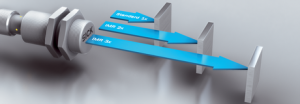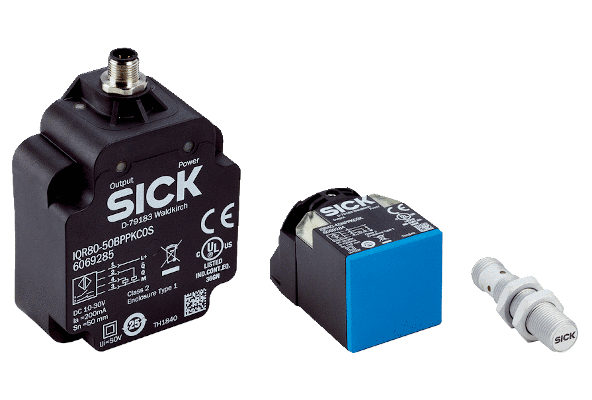The sensing of different metals with traditional ferrite core inductive sensor technology isn’t easy without physically moving the sensor as different metals will usually induce a different sensory response. Where more than one particular type of metal is present in a production line, such as steel, copper or aluminium, your typical inductive sensor will be more willing to detect the presence of steel as opposed to copper or aluminium at the same distance. To cater for this the clever people at SICK have created the IMR range of reduction factor 1 inductive proximity sensors.

The IMR range of reduction factor 1 inductive proximity sensors is the perfect addition for the production process that demands the detection of various metals in harsh processing and production environments. This range of sensors has been optimally designed for long-term use in automotive and other heavy industrial welding areas and other similar applications. With a hard-wearing non-stick PTFE coating and with no ferrite core used in their construction, the IMR range is not affected by weld spatter, slag, sparks or magnetic interference.
What is Reduction Factor 1?
The SICK IMR range of inductive proximity sensors operates using the reduction factor 1 principle. What this means is that they can detect all metals, including non-ferrous metals such as aluminium and stainless steel within the same sensing range as ferrous metals. With sensing ranges of up to 75 mm, this helps to reduce incidents of mechanical sensor damage by detecting objects before they can physically impact the sensor, helping prevent unnecessary process downtime and increasing plant availability.

Typical Applications:
- Monitoring of clamping devices in welding processes
- Presence monitoring in welding processes and sheet metal punching
- Presence monitoring in material feed units such as lathes
- Positioning of skid conveyors

SICK IMR Range Benefits:
- Switching errors due to electromagnetic fields are prevented
- Long service life for welding applications due to PTFE coating
- Huge sensing range for all metals including aluminium, stainless steel, copper and more, reducing mechanical damage
- Simple and reliable detection of all objects made from different metals
- Suitable for harsh environments with the IP68 rating and extended temperature range
- Cylindrical design with high switching frequencies for fast automation processes
Built with the latest application-specific integrated circuitry (ASIC) results in the IMR range having excellent EMC properties making them the first choice for use in the automotive construction industry.

SICK IMR Range Features:
- Size ranges: M8 to M30, square bodied versions – 40 x 40 mm & 80 x 80 mm
- Increased sensing range of up to 75 mm
- Electrical configuration – DC 3/4 wire
- IP68 enclosure rating
- Operating temperature range –30° C to +85° C
- Protective non-stick PTFE coating on cylindrical models
- Reduction factor 1 for all metals
Learn more about the IMR Range
Read More about Inductive Proximity Sensors

Kempston Controls, as a supplier partner for SICK, can supply you with any of the IMR range of reduction factor 1 inductive proximity sensors you require. Even if we don’t have the items you need in stock, we can certainly source them for you. Give our dedicated sales team a call on +44 (0) 1933 411411 or email us at sales@kempstoncontrols.co.uk to discuss your SICK IMR reduction factor 1 inductive proximity sensor needs.

Kempston Controls is committed to finding you the ideal solution for your application. Call us today on +44 (0) 1933 411 411, email us at sales@kempstoncontrols.co.uk, or alternatively contact us here, we will be happy to help.

